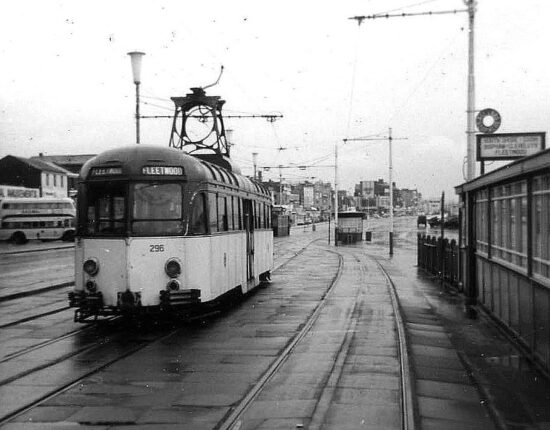A tram which looks very different now is the feature of today’s Picture in Time image – it is Blackpool Brush 296.
Having entered service in Blackpool on 28th August 1937 having been built by Brush at their Loughborough works, 296 was one of a once 20 strong class of single deck trams partly ordered to add capacity to the Blackpool tram fleet during the illuminations season after the closure of the Lytham and St Annes tramway (who Blackpool loaned in trams from for the illuminations). Similar but different in every way to the previous English Electric Railcoaches the Brush Cars would end up becoming mainstays of the Blackpool fleet for over 70 years with the vast majority still surviving in some form today. As for 296 this tram received some modernisation over the years until it was withdrawn from service in 1997. By this time it had been renumbered 633 and it soon entered the workshops for a rebuild but unlike other Brush Cars in the late 1990s/early 2000s it was going to have a radical new style as it was chosen to become the first new illuminated feature car for over 30 years. With sponsorship from Fisherman’s Friend it was rebuilt into a Trawler but whereas previous feature cars were for tour use only it was built with the idea that it could be used as a normal Railcoach as necessary as well. Entering service for the 2001 illuminations the tram soon became the only illuminated tram available before first the Frigate and then the Western Train returned to the tracks. Now numbered 737 the tram underwent further workshop attention in 2016 before returning to service with state of the art LED lighting.
In this view we see 296 on 21st January 1967 carrying the standard half green/half cream livery of the time whilst running a service to Fleetwood. The location is Tower.


You mention that the Brush Cars were actually quite different to the EE Railcoaches. What was it that made them so?
Much of the difference was apparently down to English Electric protecting their designs. This is quoted from the book Blackpool’s Century of Tram by Steve Palmer.
The body design was quite different in that the cab ends were more streamlined that the English Electric railcoaches which had a more upright appearance. They were arguably more luxurious inside as well. They had air operated platform doors which could be operated by the driver. Under the skin they ran on EMB light weight flexible suspension bogies where the axleboxes are bolted directly to the leaf spring with no guidance horns on the bogie frame. This allows very slight movement of the axle as the tram enters a curve an is intended to reduce wear and improve curving. The controllers were from Allen West and motors from Crompton Parkinson whereas the English Electric railcoaches used EE equipment. Being non-standard they were said to be unpopular (unlike now) and for a number of years were concentrated on Bispham depot for the Fleetwood to North Station route until its closure. In later years as early series one English Electric railcoaches were withdrawn the Brush cars took their EE equipment allowing standardisation. The EMB bogies remained though.
I have to say I personally always preferred the looks of the English Electric Series 1 and 2 railcoaches for some reason, I suppose beauty is in the eye of the beholder. I have never been a fan of streamlining and the more restrained outline of the EE railcoaches pleased my eye. For the same reason I have never liked the Balloons with their steam lined top decks(runs away in terror!).
Thank you so much. Absolutely fascinating, will google pictures of each type and make cab end comparisons.
Wow, having made the comparisons you can really see so many differences.
Can’t agree with the comments about the Balloons though. They are a thing of beauty.
*Some* are a thing of beauty. Not the widened ones, obviously. I still think its a shame that 700 was ruined and has very rarely (if ever?) been used as intended.